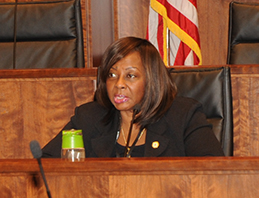Lack of trauma centers means lives are being lost, say concerned lawmakers and officials
 Someone shot or otherwise seriously injured on Chicago’s violence-plagued South Side waits nearly 50 percent longer to get to a trauma center than anywhere else in the city, a delay that medical experts say costs lives and that local community leaders and a leading area lawmaker say is simply unacceptable.
Someone shot or otherwise seriously injured on Chicago’s violence-plagued South Side waits nearly 50 percent longer to get to a trauma center than anywhere else in the city, a delay that medical experts say costs lives and that local community leaders and a leading area lawmaker say is simply unacceptable.
The situation came under the spotlight earlier this week when Illinois State Senator Mattie Hunter, a Chicago Democrat, convened the first-of-its kind hearing looking into the lack of trauma centers across a wide swath of the city’s South Side.
These neighborhoods have been dubbed “trauma center deserts” because of the scarcity of high-level emergency care for adults. The real-world implications are that victims of violence have to be transported greater distances in situations where every second can be precious.
“We’re in a dire situation,” said Senator Hunter, who heads the Senate Public Health Subcommittee on Special Issues that is investigating the issue. “The South Side needs trauma centers to reduce the number of violence-related deaths.”
Hunter, a member of the Senate Democratic leadership team, launched the Illinois Senate inquiry in response to a recent WBEZ study that found it took ambulances 50 percent longer to transport a patient on the southeast side to a trauma center than in other regions of the city. The media outlet found that 75 percent of the ambulance travel times from the South Side were longer than 20 minutes and 24 percent took longer than 30 minutes.
In addition, there were at least 15 accounts of ambulances taking longer than 40 minutes to reach a trauma center.
In such critical instances, these delays can mean the difference between life and death. Medical professionals testified that when a trauma center is less than five miles away and can be quickly accessed, a victim’s chances of survival greatly increase.
“It’s clear that if there was a center on the South or Southwest Side, the differences in transport times could be eliminated,” said Dr. Marie Crandall, trauma surgeon and researcher at Northwestern University’s Feinberg School of Medicine.
Meanwhile, community advocates say the lack of trauma centers further victimizes already ravaged neighborhoods.
“I’ve been a South Side resident for the last 21 years of my life and seeing 9- and 10- year-olds being taken to trauma units for gunshot wounds is a part of everyday reality,” said Veronica Morris-Moore, Youth Organizer for Fearless Leading by Youth.
Both Dr. Crandall and Morris-Moore testified before Hunter’s subcommittee. They were joined by the Illinois Hospital Association and several other concerned citizens and organizations.
The hearing marked the first time the state has reached out to community groups to discuss the lack of access to trauma facilities. Hunter said the hearing is merely the beginning of her efforts to raise awareness of the situation in hopes of getting a trauma center opened soon.
“This hearing was a great opportunity to hear all sides of the issue,” Hunter said. “Immediately after the hearing, I scheduled several meetings with the University of Chicago, the Illinois Hospital Association and the student organization Fearless Leading by Youth so concrete solutions can be formed.”
To listen to audio from an interview with WBEZ on the subject click below:
For more information about the hearing view this story by ABC 7 Chicago.
